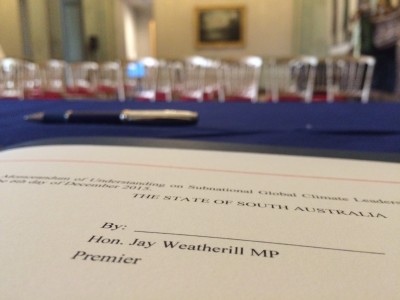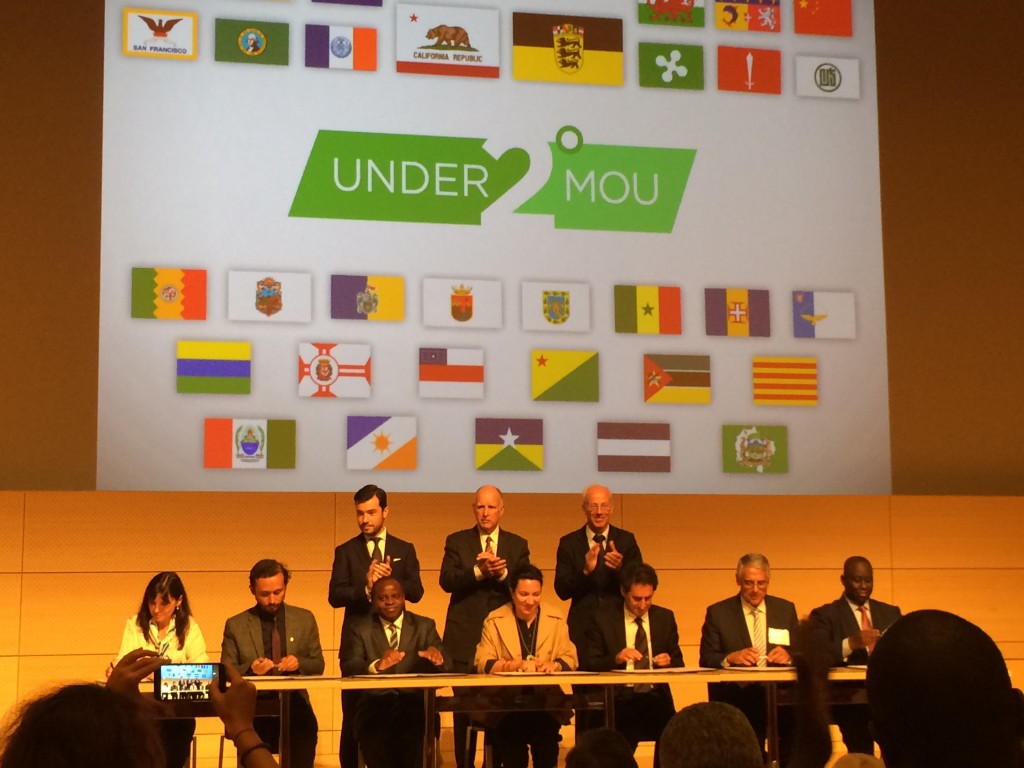With the Trump administration putting the brakes on national climate efforts, such as the Clean Power Plan, action will shift to the states. But California is doing more than just reducing its own carbon footprint, it’s signing up cities and states around the world to commit to the same.
Capitol Public Radio ran a story yesterday on the “Under 2 MOU,” which is the memorandum that binds the coalition states to reduce greenhouse gases to under 2 degrees warming by 2100. International law students in a class I helped teach at Berkeley Law helped develop new strategies for their home country jurisdictions and were featured on the radio piece:
…Ken Alex, who oversees the organization for Jerry Brown, says the organization has little, if any, stable funding.“We’re learning, we’re building the airplane as we’re flying it,” Alex says. He notes the organization has more signatories than the Paris Agreement. “And oh by the way there are at least 10 languages.”He counts one full-time employee working on it. Instead, Under2 has largely relied on informal arrangements.For instance, a U.C. Berkeley professor who does work in Kenya helped Laikipia calculate its total emissions. Another class at Berkeley law school, made up of international students with law degrees in their home countries and taught by a former colleague of Alex’s, is scouting potential new allies.
The work of the international students is helping to identify new potential coalition partners and strategies for existing ones to follow through on their pledges. It’s a shining example of state and local leadership — around the world — at a time when our federal government appears to be moving backwards.
After last night’s presidential election results, it’s easy to despair that we’ve lost the fight against climate change. Trump will likely kill the federal Clean Power Plan and pull the U.S. out of the Paris agreement. He’ll also probably pull back regulations that make it harder to permit coal-fired power plants and conduct other business activity that furthers a fossil fuel-powered economy.
Yes, California’s climate program will continue, as a bright spot. But the state relies on the federal government in crucial ways to lessen the economic burdens to Californians of the transition to a clean economy. The immediate examples that come to mind are the federal tax credits and research on solar and wind energy, tax credits for electric vehicles and associated charging infrastructure, and general support for and research on energy storage technologies. Without that support, California’s climate policies will likely become more expensive and potentially politically unpopular.
So where do climate advocates go from here? My colleague Dan Farber’s post on Legal Planet is right on: use political leverage, the courts, and continued state action. But I fear the first two options will be made more difficult given the potential for a coming breakdown in our governance system, as the full weight of “11/8” is felt in our institutions, from the courts to congress to the media.
That leaves state action. And in this respect, as Dan described, there may be cause for hope. In fact, given the hostile national politics during even the Obama years with a Democratic congress, this election may be an important wake-up call about the most viable path forward, politically speaking — even had Clinton won. Especially since the federal Clean Power Plan, which represents the high-water mark for federal action given congressional resistance, has pretty weak targets that won’t set in for years.
California is the obvious state leader here, but so are other west coast and northeast states. We’re long past the time when those states should join together for unified policies to boost clean technologies and price carbon. Those coalitions are happening fitfully but need to be accelerated. That means unified carbon markets, incentives for renewables, and a common market for electric vehicles, among other policies.
Internationally, the Paris agreement was always just a paper commitment. Action to achieve the ambitious international targets will still require courageous policies at the state and subregional level. And now that the Paris agreement is called into question under a Trump administration, we can see the wisdom of California’s approach to sign up subnational entities to commit to this fight. The “Under 2 Coalition,” as it’s now called, represents 136 cities and states with 832 million people and $22 trillion in GDP. It’s the brainchild of Governor Jerry Brown’s senior advisor Ken Alex, and it may represent the world’s best hope to achieve the goals spelled out in the Paris accord.
So while many climate advocates will be playing defense at the federal level for the foreseeable future, the offensive play, to my mind, is through state coalitions and bolstering of the Under 2 Coalition. It’s not going to be easy, but it was always an uphill battle anyway. And while the climb is now steeper, we still have a way forward.
 What started as a series of informal conversations about a year ago among Governor Brown, his senior staff, and a few world leaders, has turned into a veritable global movement. The “Under 2 MOU,” which I blogged about on Thursday, just bumped its total from 57 signatories last week to 80 today, with each representing a city, state or region around the world that is pledging to limit global warming to under 2 degrees by 2100. That signatory number is expected to increase further this week during the UN climate negotiations in Paris.
What started as a series of informal conversations about a year ago among Governor Brown, his senior staff, and a few world leaders, has turned into a veritable global movement. The “Under 2 MOU,” which I blogged about on Thursday, just bumped its total from 57 signatories last week to 80 today, with each representing a city, state or region around the world that is pledging to limit global warming to under 2 degrees by 2100. That signatory number is expected to increase further this week during the UN climate negotiations in Paris.
Governor Brown and the U.S. Ambassador to France, Jane Hartley (fresh off hosting President Obama at her residence), co-hosted a signing ceremony at the Ambassador’s Residence in Paris today, which I attended as part of Berkeley Law’s sponsorship of the luncheon that followed.
The signing ceremony included signatory states and regions from places like Brazil, Holland, and Australia, as well as cities closer to home like Austin and Oakland. The event featured a press conference with remarks from the ambassador, governor, and a representative from the German state of Baden-Württemberg, which launched this effort with California earlier this year. With 30 media representatives in attendance, the hope is that this effort will get strong publicity both in California and around the world to encourage international negotiators this week in Paris to strike a more aggressive climate agreement.

Governor Brown addresses the luncheon following the Under 2 MOU signing.
In the luncheon that followed for Brown Administration officials, California’s business delegation, and other environmental leaders and elected officials from around the globe, Governor Brown noted that even the “Under 2” goal by 2100 many not be enough. Scientists say that even with two degrees warming, it only gives humanity a 50% chance at averting catastrophic climate change. “I don’t know about you,” Brown said, “but how many of us would board an airplane if it only had a 50% chance of not crashing? I want to see that 50% chance of catastrophe become 0%.”
But short of changing the name to the less-catchy “Under 1.5” MOU, this subnational effort may be one of the best chances that climate advocates have for pushing strong, global action on climate change. Particularly with the international process getting bogged down by deference to the lowest common denominator, as Ted and Cara have blogged about, an agreement among more progressive subnationals could lay the foundation for strong global coordination, albeit at a different level than what negotiators will hopefully be finalizing this coming week.
Credit for this Under 2 MOU certainly goes to the governor and other elected officials, but also to his senior advisor (and Legal Planet guest-blogger) Ken Alex, who helped brainstorm the idea, as well as a dedicated staff from California’s “State Department” in the Brown Administration. With so many roadblocks on the U.S. national and international scene, it’s encouraging to see how much progress California is making at home and now globally.

Governor Brown witnesses subnational leaders from around the globe signing the “Under 2 MOU” Thursday in New York.
Last night subnational leaders from around the globe gathered in New York City to sign the California-led “Under 2 MOU” pledge. The effort involves getting big cities and states within nations to commit to limiting warming to under two degrees centigrade by 2100 (hence the “under 2” name).
Governor Brown was on hand to witness the signing, and Berkeley Law helped support the event, which was I was there. More from the Washington Post on it:
The additions Thursday brought to nearly 40 the number of major cities and provinces to sign the extraordinarily ambitious — though nonbinding — pact. Signers commit to either cutting pollution to 80 to 95 percent below 1990 levels, or attaining a per capita emissions goal of two metric tons of carbon emissions by 2050. The current per capita average of U.S. citizens is about 18 tons.
“We’re just getting warmed up,” said California Gov. Jerry Brown (D), who helped launch the movement. “And I promise you, no opposition . . . will stop California from reaching the sustainable goals we commit to tonight.”
Brown’s office said the signers — who include representatives from New York and Mexico City — collectively represent 313 million people and more than $8.7 trillion in gross domestic product. If they were a single country, it “would be the third largest economy in the world, behind only China and the United States,” the governor’s office said in a statement.
In the remarks leading up to the event, Glen Murray, Ontario’s environment minister, actually choked up describing the impacts of climate change on some of the northern provinces in Canada. As he said, many of those areas are already at 2 degrees warmer and will likely rise to seven degrees, effectively destroying much of the way of life there.
His remarks, and the fiery comments of Governor Brown, reminded the audience of the stakes and called them to action. If the effort is successful, it will not only lead to greater cooperation among these entities in reducing greenhouse gas emissions, but hopefully force a more aggressive international treaty in Paris this December.


